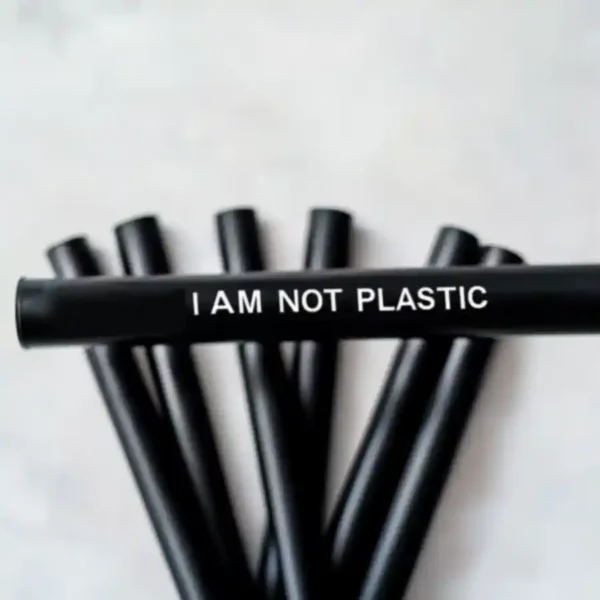The environmental impact of single-use plastics is a growing concern, and straws are a significant contributor to this problem. Plastic straws account for approximately 4% of the nearly eight million tons of plastic waste generated annually. These seemingly small items pose a significant threat to our planet, ending up in landfills and oceans where they harm wildlife and pollute ecosystems. This guide provides a comprehensive overview of sustainable straw options, helping you make informed decisions that align with your values and contribute to a healthier planet.

Why Choose Sustainable Straws?
The Problem with Plastic Straws
Traditional plastic straws present several environmental challenges. They are difficult to recycle due to their small size and shape, often clogging sorting machinery. As a result, they primarily end up in landfills or as marine debris, where they can take hundreds of years to decompose. Additionally, plastic straws are made from petroleum, a non-renewable resource, and their production contributes to greenhouse gas emissions. The accumulation of plastic waste in waterways and landfills poses a direct threat to wildlife, as animals may ingest or become entangled in the debris.
Benefits of Biodegradable and Compostable Straws
In contrast, biodegradable and compostable straws offer a more sustainable alternative. These straws break down naturally, reducing waste in landfills and oceans. They are often made from renewable resources, lessening the dependence on finite fossil fuels. Many biodegradable straws are made from plant-based materials, making them a safer option than plastic straws that may contain harmful additives. Moreover, they do not form harmful microplastics during decomposition, thus reducing their long-term impact on ecosystems and human health. By choosing sustainable straws, we can reduce greenhouse gas emissions, promoting a more eco-friendly approach.
Types of Sustainable Straws: A Detailed Comparison
The market offers a variety of sustainable straw options, each with its unique properties. This section provides an in-depth comparison to help you select the best alternative for your specific needs.
Plant-Based Options
- PHA (Polyhydroxyalkanoates) Straws: PHA is a bio-based substance derived from renewable resources like cornstarch, sugarcane, and canola oil. These straws are biodegradable in various environments, including home and industrial composting, as well as marine environments. PHA straws look and perform similarly to traditional plastic straws and are FDA-approved for food service. While versatile and durable, they tend to be more expensive with a limited supply.
- PLA (Polylactic Acid) Straws: PLA is a bioplastic made from plant-based sources such as cornstarch or sugarcane. PLA straws are biodegradable but require industrial composting facilities to break down efficiently. While they are a durable and sustainable option, they will not break down in landfills, and may lose their structural integrity in hot liquids.
- Agave Straws: Agave straws are made from the waste fibers of the agave plant, a byproduct of tequila and mezcal production. These straws are durable, similar to plastic straws, and break down quickly in landfills. They are non-toxic and biodegradable, offering a sustainable alternative to bioplastics. However, the supply of agave straws is currently limited, and there are not many options for colors and styles.
- Bamboo Straws: Bamboo is a fast-growing, renewable resource that is used to create durable and lightweight straws. Bamboo straws are biodegradable and compostable, and they do not conduct heat or cold. They are a cost-effective option, but they may have a plant-like taste or smell, absorb liquid, and may not come in various colors.
- Grass Straws: Grass straws are made from various natural grasses, such as wheatgrass or hay. They are biodegradable and compostable, undergoing minimal processing. Grass straws are a cost-effective option, but they have limited availability, a shorter shelf life, and are less durable.
- Sukkerrør sugerør: Sugarcane straws are made from bagasse, a byproduct of sugarcane processing. These straws are strong, durable, water-resistant, and fully home compostable. They are suitable for cold beverages but have limited availability and are unsuitable for hot drinks.
- Wheat and Reed Straws: Wheat and reed straws are made from the stems of renewable wheat and reeds. These straws perform well in both hot and cold beverages and do not alter the taste of the drink. They may break if pinched, and they may not have a consistent diameter from batch to batch.
Papirsugerør
Paper straws are made from wood pulp, which can contribute to deforestation. Some paper straws contain PFAS (per- and polyfluoroalkyl substances), chemicals that pose health risks and do not break down in the environment or body. While paper straws degrade faster than plastic straws and are relatively inexpensive, they tend to become soggy and may not be recyclable if contaminated with food.
Other Materials
- Sulapac Straws: Sulapac straws are made from a combination of wood and biodegradable biopolymers. They are non-soggy, industrially compostable, bio-based, and do not create microplastics.
- AirCarbon Straws: AirCarbon straws are made from a biodegradable polymer produced by bacteria from greenhouse gases. The resulting product is carbon-negative.
- Cellulose Acetate: Cellulose acetate is a robust, biodegradable substance made from plant fibers that can be broken down in industrial composting facilities.
Table Summary
| Straw Type | Holdbarhed | Kompostabilitet | Cost | Miljømæssig påvirkning |
|---|---|---|---|---|
| PHA | Høj | Home, Industrial, Marine | Høj | Lav |
| PLA | Høj | Industrial | Moderat | Moderat |
| Agave | Høj | Landfill | Moderat | Lav |
| Bambus | Moderat | Hjem | Lav | Lav |
| Grass | Lav | Hjem | Lav | Lav |
| Sugarcane | Høj | Hjem | Moderat | Lav |
| Wheat/Reed | Moderat | Hjem | Moderat | Lav |
| Papir | Lav | Home (if uncoated) | Lav | Moderat |
| Sulapac | Høj | Industrial | Høj | Lav |
| AirCarbon | Høj | Industrial, Natural Environment | Høj | Very Low |
| Cellulose Acetate | Høj | Industrial | Moderat | Lav |
Understanding Disposal Methods
It is crucial to understand the differences between biodegradable, compostable, and marine-degradable materials to ensure proper disposal.
Biodegradable vs. Compostable vs. Marine-Degradable
- Bionedbrydeligt straws break down naturally into simpler compounds over time when exposed to environmental conditions.
- Komposterbar straws are designed to degrade in composting facilities under controlled conditions.
- Marine-degradable straws can break down in marine environments, disintegrating into harmless substances without harming marine life.
Home Compostable vs. Industrial Compostable
- Home-compostable straws can break down in home composting systems under normal conditions.
- Industrial-compostable straws require higher temperatures and microbial activity in industrial composting facilities to decompose fully within a shorter time frame.
Practical Advice for Disposal
Dispose of straws according to their material. Paper and agave straws are generally biodegradable in landfills, while bioplastics like PHA and PLA require industrial composting. Some straws, like Nodax PHA, are marine biodegradable. Understanding these differences can help you make appropriate disposal decisions.
Choosing the Right Straw for Your Needs
Selecting the appropriate sustainable straw involves considering various factors, including your specific needs.
For Businesses
- Restaurants and Cafes: Prioritize durable straws that meet customer preferences. Consider PHA or Sulapac straws for their robust nature and customer appeal.
- Bars: Focus on straws that look good in cocktails, such as plant-based straws or bamboo.
- Fast Casual and Takeout: Choose options that balance convenience with proper disposal. PHA or cellulose acetate straws offer a good balance of sustainability and performance.
For Consumers
- Everyday Use: Opt for reusable options, like metal or silicone, or eco-friendly disposables such as PHA or agave straws.
- Special Needs: Choose bendable straws that are suitable for individuals with disabilities, such as those made from PHA.
Factors to Consider
When choosing a straw, consider:
- Cost-effectiveness: Some options are more expensive, but long-term savings may be possible.
- Durability: Choose straws that can withstand intended use.
- Aesthetics: Select straws that align with your brand or personal preferences.
- End-of-life: Ensure proper disposal is feasible, according to the straw’s compostability.
- Availability: Consider the supply and scalability of the chosen material.
- Certifications: Look for certifications from organizations such as BPI, CMA, or TUV Austria to ensure the product meets industry standards for compostability.

Addressing Common Concerns
Several concerns often arise when switching to sustainable straws.
- Sogginess: Paper straws are known to get soggy quickly. PHA, Sulapac, agave, and bamboo straws are more resistant to sogginess.
- Cost: Sustainable alternatives may initially cost more than plastic straws, but prices are becoming more competitive.
- Taste/Odor: Some plant-based straws may have a plant-like taste or smell.
- Availability and Scalability: Some straw options have limited suppliers or are difficult to scale up for mass production.
Beyond Straws: Reducing Waste Holistically
In addition to choosing sustainable straws, consider other ways to reduce waste:
- Encourage “Strawless” Options: Promote drinking directly from the cup and use lids designed for straw-free drinking.
- Incentivize Reusable Straws: Offer discounts to customers who bring their own straws.
- Focus on other Single-Use Items: Use compostable cups, containers, and cutlery.
- Promote Responsible Consumption: Reduce unnecessary straw use by asking guests about their preferences and using straws only when necessary.
The Future of Sustainable Straws
Technological innovations will continue to bring new materials and manufacturing processes to the market. Single-use plastic bans and policies are also influencing the industry, encouraging businesses and individuals to switch to sustainable options.

Frequently Asked Questions (FAQs)
● What are the main types of biodegradable straws?
○The main types include PHA, PLA, paper, agave, bamboo, grass, sugarcane, plant-based, and cellulose acetate straws2.
●How do biodegradable straws differ from compostable straws?
○Bionedbrydeligt straws break down naturally but at different rates and conditions, while compostable straws require specific composting facilities to degrade4.
●Are PHA straws marine degradable?
○Yes, PHA straws are often marine degradable, meaning they can break down in marine environments without harming wildlife24.
●Do PLA straws break down in home compost bins?
○No, PLA straws require industrial composting facilities to break down effectively2.
●Are paper straws a sustainable option?
○Paper straws are cost-effective, but they often become soggy, lack durability, and may contain harmful PFAS chemicals2.
●Where can I find agave straws?
○Agave straws can be found at Greenprint2.
●What are the benefits of using sugarcane straws?
○Sugarcane straws are water-resistant and home compostable, but not suitable for hot beverages2.
●How can I tell if a straw is industrially compostable?
○Look for certifications that indicate industrial compostability. Typically, the packaging or product information will specify this3.
●What are some brands that make sustainable straws?
○Phade is a popular brand of PHA sugerør, og Sulapac offers a unique material for straws23.
●Why are plastic straws bad for the environment?
○Plastic straws are difficult to recycle, contribute to pollution, harm wildlife, and are made from unsustainable petroleum1.
Konklusion
Choosing sustainable straws is a critical step in reducing plastic waste and promoting environmental stewardship. By understanding the various materials available, considering the specific needs of businesses and consumers, and ensuring proper disposal practices, we can create a more sustainable future. Both consumers and businesses can make informed choices and advocate for policies that support a healthier planet.







